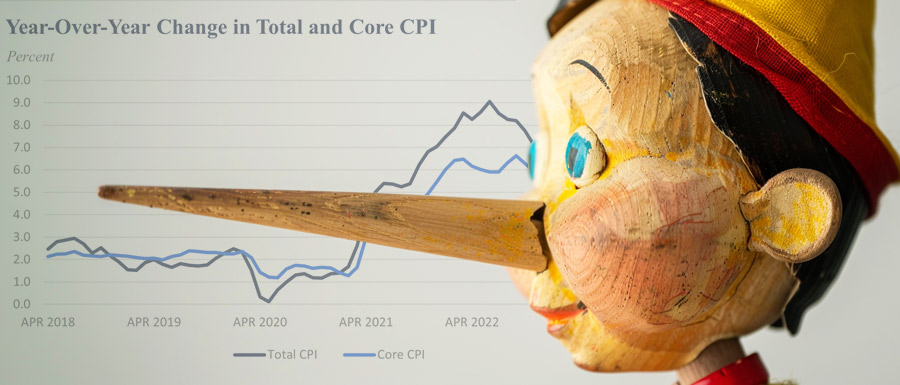
Three Reasons to Be Skeptical of Government CPI Numbers
 Bullion.Directory precious metals analysis 23 February, 2024
Bullion.Directory precious metals analysis 23 February, 2024
By Mike Maharrey
Journalist, analyst and author at Money Metals Exchange
According to the latest Consumer Price Index (CPI) data, prices rose by 3.1 percent over the last year.
Based on my own experience at my local shopping center, that seems low.
And it may well be.
There are reasons to doubt the accuracy of CPI data.
According to a recent report released by the Bureau of Labor Statistics (BLS) weak response rates to CPI surveys. This calls the accuracy of the data into question.
I think most people intuitively approach government economic data with at least a grain of skepticism. After all, government people have a vested interest in making us think the economy is humming along just fine. You might call this cynical, but there are also rational reasons to doubt the data.
This includes the CPI calculation.
In the first place, we know the government “adjusted” the CPI back in the 1990s to consistently make price inflation lower.
In reformulating the CPI, the BLS followed the recommendations of the Boskin Commission, a committee appointed by the Senate. Originally called the “Advisory Commission to Study the Consumer Price Index,” the committee’s job was to ferret out possible “bias” in the computation of the CPI. You’ll be shocked to learn that this government commission discovered “bias” that was making the government look bad.
Ultimately, the Boskin Commission determined that the consumer price index overstated inflation — by about 1.1 percent per year in 1996 and about 1.3 percent prior to 1996. Based on these conclusions, the BLS went about making changes to CPI to address this “issue” by ensuring the formula consistently spit out smaller numbers.
The second problem with the CPI is that it is relatively subjective.
The BLS calculates CPI by analyzing the total price of a “basket of goods.” Obviously, the things the government chooses to put in that basket and the weight it assigns to each category have a big impact on the final CPI number.
This subjectivity leads us to the third problem: the entire formula is based on surveys.
Now, you might think scientists at the BLS are doing some kind of in-depth sciencey stuff to come up with the CPI data.
Nope.
They just ask people a bunch of questions.
We all know this isn’t the most accurate way to collect information. After all, the person on the other end of the phone call or email can say anything. Sure, they might be really committed to providing precise information. Or they may have indigestion and just want to get the survey-taker off the phone.
Or, they might not pick up the phone at all.
Apparently, this is a growing problem for the BLS.
According to the latest report, the number of completed surveys used in the CPI calculation came in at 71 percent. That is well below the pre-pandemic trend of 80 percent.
The BLS admits that this is a problem.
Failure of a data unit to respond at either the data collection stage or estimation stage represents a loss of statistical information which dilutes the accuracy of the sample. [Emphasis added]
According to a Bloomberg report, the BLS changed its data collection methods during the pandemic, relying less on in-person interviews and more on phone calls, emails, and online surveys.
This isn’t just a problem for CPI calculations. A report last year indicated that response to the Job Openings and Labor Turnover Survey (JOLTS) had fallen to as low as 30 percent.
As Bloomberg reporter Rease Pickert put it, the lack of survey responses “introduces the higher potential of error, essentially because you’re having to do kind of more adjustment.”
Adjustment translates to government people massaging the data to come up with an answer.
If you trust these folks to “adjust” the data in a fair and unbiased way, more power to you.
But nobody would blame you if you took this government economic data with a grain of salt.
Or maybe a salt shaker.
Mike Maharrey


Mike Maharrey is a well-known author, journalist, financial analyst and writer at Money Metals Exchange, one of our top-rated US dealers and two-times winner of Bullion Dealer of the Year
He holds a BS in accounting from the University of Kentucky and a BA in journalism from the University of South Florida. Mike also serves as the national communications director for the Tenth Amendment Center and the managing editor of the SchiffGold website.
This article was originally published here
Bullion.Directory or anyone involved with Bullion.Directory will not accept any liability for loss or damage as a result of reliance on the information including data, quotes, charts and buy/sell signals contained within this website. Please be fully informed regarding the risks and costs associated with trading in precious metals. Bullion.Directory advises you to always consult with a qualified and registered specialist advisor before investing in precious metals.









 Material provided on the Bullion.Directory website is strictly for informational purposes only. The content is developed from sources believed to be providing accurate information. No information on this website is intended as investment, tax or legal advice and must not be relied upon as such. Please consult legal or tax professionals for specific information regarding your individual situation. Precious metals carry risk and investors requiring advice should always consult a properly qualified advisor. Bullion.Directory, it's staff or affiliates do not accept any liability for loss, damages, or loss of profit resulting from readers investment decisions.
Material provided on the Bullion.Directory website is strictly for informational purposes only. The content is developed from sources believed to be providing accurate information. No information on this website is intended as investment, tax or legal advice and must not be relied upon as such. Please consult legal or tax professionals for specific information regarding your individual situation. Precious metals carry risk and investors requiring advice should always consult a properly qualified advisor. Bullion.Directory, it's staff or affiliates do not accept any liability for loss, damages, or loss of profit resulting from readers investment decisions.

Leave a Reply